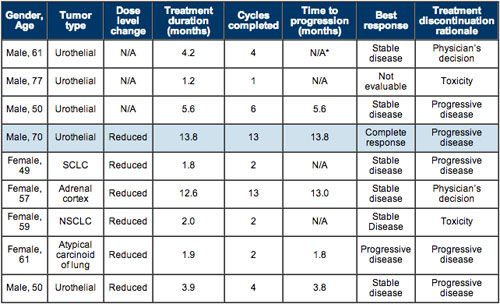mTOR Mutations in Exceptional Responder Suggest Sensitivity to Everolimus in Bladder Cancer
An exceptional responder with advanced urothelial carcinoma experienced a complete radiologic response lasting 13.8 months following treatment with the combination of everolimus (Afinitor) and pazopanib (Votrient).
Nikhil Wagle, MD

Nikhil Wagle, MD
An exceptional responder with advanced urothelial carcinoma experienced a complete radiologic response lasting 13.8 months following treatment with the combination of everolimus (Afinitor) and pazopanib (Votrient), according to results from a phase I trial that were published in the journalCancer Discovery.
As defined by the National Cancer Institute, exceptional responders are patients who experience a complete or partial response for at least 6 months in a trial in which only 1% to 10% of patients respond. The exceptional responders initiative was designed to help improve the biological understanding of cancer while developing more effective therapeutics and diagnostic tools. As part of the initiative, whole-exome sequencing of the tumor and normal DNA was conducted, which revealed two mutations inmTORthat had not previously been implicated in human cancer.
The study of exceptional responders “has the potential to identify novel genomic and molecular mechanisms of sensitivity to many different anticancer therapies,” Nikhil Wagle, MD, an instructor in medicine at Dana-Farber Cancer Institute and lead author of the study, wrote. “The ultimate goal of such an approach is to use those mechanisms for prospective identification of patients who might similarly respond to those specific therapies.”
Further laboratory studies of these mutations, identified asmTOR E2419KandmTOR E2014K, showed mTOR-mediated cell-signaling pathway activation. The authors of the study wrote that the mutations caused the cancer to become dependent on the mTOR pathway causing the development of clinically significant sensitivity to mTOR inhibition.
“Results of our study suggest that we should make a catalogue of activating genomic alterations in the genes in the mTOR pathway,” Wagle said in a statement. “Patients with tumors that harbor these alterations might be particularly suitable for treatment with drugs like everolimus and other mTOR inhibitors.”
Table. Patient Characteristics and Efficacy
Patient Characteristics and Efficacy

* Patient had one disease assessment and was reported to have stable disease at 3.8 months
The activatingmTOR E2419Kmutation is located in the kinase domain of mTOR and its homolog. This gene was previously identified in a fission yeast screen and studied in human cell lines. ThemTOR E2014Kmutation occurs in the FKBPrapamycin-binding domain ofmTORand has been identified to be present in the urothelial cancer cell line U-BLC1.
Nine patients who had progressed on standard therapies were enrolled in this trial: 5 with urothelial carcinoma, 1 with small cell lung cancer (SCLC), 1 with nonsmall cell lung cancer (NSCLC), 1 with atypical carcinoid tumor of the lung, and 1 with adrenocortical carcinoma. Patients received a median of 4 cycles (ranging from 1-13) of everolimus and pazopanib.
The study used a standard 3 + 3 dose finding design that started with oral everolimus 5-mg and oral pazopanib 600-mg once daily during a 28-day cycle. The study planned to alternate escalation to 10-mg everolimus and 800-mg pazopanib daily or de-escalation to 5-mg everolimus and pazopanib at 400 mg daily.
In the trial, 3 patients (all with urothelial carcinoma) stayed on the regimen of everolimus at 5 mg and pazopanib at 600 mg. The remaining 6 patients, including the exceptional responder, were de-escalated to everolimus at 5 mg and pazopanib at 400 mg.
The maximum tolerated dose was determined to be everolimus at 5-mg and pazopanib at 400-mg. The most common toxicities in the trial were fatigue (n = 5), nausea (n = 4), vomiting (n = 3), diarrhea (n = 2), and rash (n = 3; 1 patient with grade 3).
Over the course of the study, disease stabilization was accomplished in 6 patients (67%) with 1 complete response (11%) for an overall disease control rate of 78% (Table).
Everolimus is currently approved for the treatment of advanced hormone receptor-positive HER2-negative breast cancer, advanced pancreatic neuroendocrine tumor, advanced renal cell carcinoma, and subependymal giant cell astrocytoma and angiomyolipoma with tuberous sclerosis complex.
Pazopanib is approved for the treatment of advanced renal cell carcinoma and advanced soft tissue sarcoma.
The Next Generation Fund at the Broad Institute of MIT and Harvard, the National Human Genome Research Institute, GlaxoSmithKline, and Novartis funded the study.